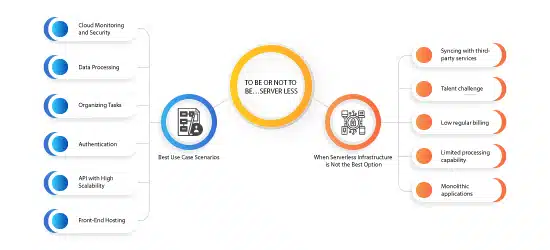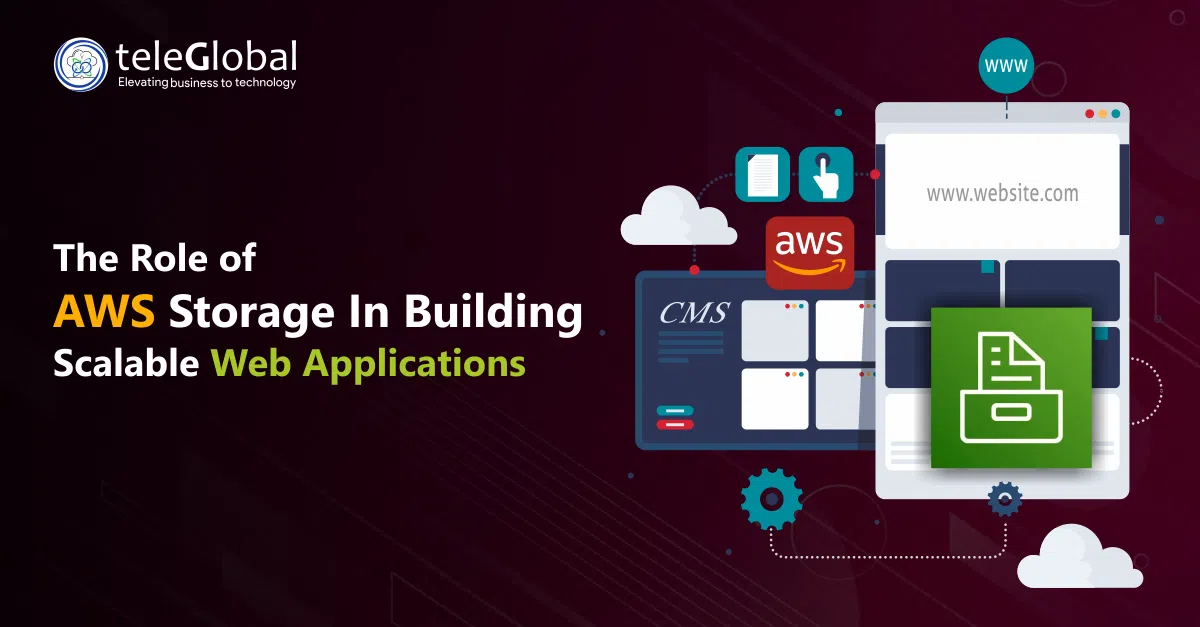
Managing IT infrastructure in a traditional set up is expensive, laborious, and effort-intensive. It calls for constant monitoring, upgrades, engaging resources to meet changing technical expertise, meeting security compliances, etc.
So, the speed with which Serverless technology has been adopted is hardly surprising. It enables organizations to escape the hassle of server management, reduce spends of IT resources, while deploying applications with high availability and near-limitless scalability.
This is why serverless infrastructure is often employed for processes that run in the background, for instance: user authentication, and database updates. Serverless is also ideal to run event-driven systems, web applications, and static websites at scale. Since, it’s impossible to predict and ensure availability for event driven requirements, applications would be required to run constantly. This would be frightfully expensive. Serverless eliminates this completely, as it doesn’t need to run code continuously for execution. It permits functions to configure only the parts of the applications needed to be run whenever they are needed. This need-use scenario makes Serverless highly efficient and has led all to its inclusion in the offerings by all major cloud providers.
Best Use Case Scenarios
Estimates by Gartner put Serverless usage at 50% of all organizations by 2025—that’s more than a 100% jump from its current 20%. While there are some scenarios where going Serverless is not the best choice, the ones below definitively call for Serverless:
- Cloud Monitoring and Security : Security, be it in the cloud or on the ground, demands continuous monitoring, and cloud offers several tools natively designed for use with cloud infrastructure. By integrating AWS Lambda functions with CloudWatch, for instance, you can actively monitor security or related metrics of your cloud environment or particular component of your environment. In this manner you can eliminate need for infrastructure dedicated only for monitoring.
- Data Processing: Data processing is often viewed as grunt work; but it is valuable currency for organizations. Given the volume, continuity and diversity that defines data, it demands considerable and continuous computing muscle. AWS provides a host of managed services including AWS Athena, Glue, and Elastic Map Reduce (EMR). These can be integrated within a Serverless architecture to meet data processing challenges, now and in the face of possible future complications.
- Organizing Tasks: Previously, organizations would program triggers to run required tasks—a waste when tasks were idle. By integrating AWS Lambda with CloudWatch organizations can achieve the same outcomes without bothering about underlying infrastructure. A note here: As AWS Lambda has limits in terms of time duration, it is better to take a more flexible approach to task organization. Dismantling it into smaller batches can do this.
- Authentication: Permission controls are a critical part of web services. By combining AWS Lambda and Amazon API Gateway with Amazon Cognito—a reliable authorization and authentication service, you can handover the vital role of allowing or denying request-to-access API Gateway.
- API with High Scalability: Building APIs in a traditional IT environment is effort-intensive, when the same activity is shifted to a Serverless environment, it is almost effortless, as there is no need to support and maintain Serverless applications. Route53 on API Gateway, for instance provides very scalable API endpoints that can be deployed in different environments.
- Front-End Hosting: Serverless has improved organisations performance in many ways: content delivery, for instance. It also reduces operational overheads, allowing front-end applications to run at ultra-low latency. Using IaC tools—such as Terraform, speed up integration of front-end software development with Serverless infrastructure.
When Serverless Infrastructure is Not the Best Option
There is no disputing the many advantages of Serverless technology. But there are some scenarios when it is not the best fit. These are the main ones.
- Syncing with third-party services: Organizations are always looking for ways to leverage outcomes, this usually required development of applications using various services. This is good, but, as the application grows and evolves, switching to external third part service providers—for databases, for instance—will prove challenging, and require a major overhaul.
- Talent challenge: It is only natural for organizations to recreate their code for events and functions to synergise with Serverless. But, while the basics of cloud are quickly grasped, the ability to work with cloud aspects—like Serverless, needs time and takes expertise.
- Low regular billing: For organizations whose monthly bill for public cloud with a pay-as-you-go model is roughly the same or even lower than serverless, the switch makes little sense.
- Limited processing capability: Serverless infrastructures are unfortunately not unlimited in their processing abilities. Multiple users uploading huge documents that need processing on several tasks are apt to receive Denial-of-service (DoS).
- Monolithic applications: Serverless was created with the intent of redefining how we build, consume, and integrate cloud-native applications.’ It is meant for applications that have minimal code and need to be deployed rapidly. Thus it is not suitable for monolithic applications.
Need more clarity about whether or not your organization needs Serverless or how to best leverage the technology? Reach out; our experts will be happy to help.








































